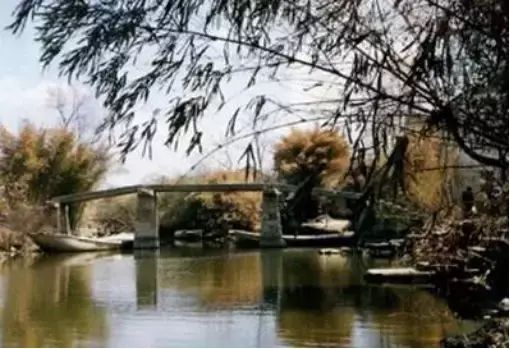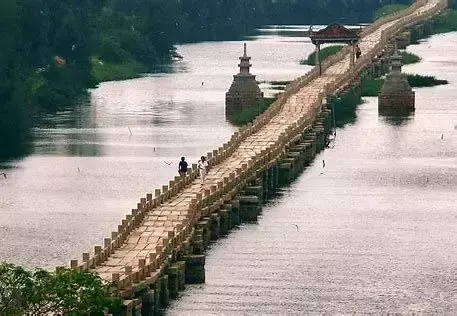Bamboo Rat Collects Historical Events

(The image of Hongqiao in the Qingming River Scene)
There are many bridges of different shapes and materials crisscrossing the mountains and rivers in our country. They are either located on thoroughfares or linking villages. They play an important transportation role.
After historical elimination and selection, among the existing bridges in our country, the two categories that are the most widely distributed are girder bridges and arch bridges.
Beam Bridge

(Quanzhou East Luoyang Bridge, formerly known as Wan'an Bridge, a beam bridge as famous as Zhaozhou Bridge)
Beam bridge can be said to be the earliest and most widely used bridge in my country. Its basic structure looks like a flat road on the water: the piers are used as horizontal support points, and then beams are placed on them and built in a flat manner. For this reason, beam bridges are also May be called"Pingqiao".

(Jishan Bridge, Kunshan County, Jiangsu)
Due to their early appearance, beam bridges had different material structures in different historical periods. Early beam bridges were mostly wooden structures. For example, in the early Pre-Qin period, beam bridges were generally "wooden beams and wooden pillars" bridges, that is, logs were used as piers standing in the water. However, people soon discovered that wooden bridge piers It is easy to be destroyed by river erosion, so during the Qin and Han Dynasties, most beam bridges were built with a "stone pillar and wooden beam" structure. The piers of this type of beam bridge are made of stone axles and columns, which are stronger than wooden pillars, so they can be The bridge body is erected longer. Today's Ba Bridge and Chan Bridge in Xi'an are examples of this type of beam bridge.
In the Han Dynasty, there was a great progress in the structure of beam bridges, that is, the emergence of stone piers. This type of bridge piers directly carved from stone is more stable than using stone pillars as bridge piers. Can resist the impact of rapids. Depending on the number of stone piers, it can also be divided into a double-span girder bridge with one pier in the middle and a multi-span girder bridge with many piers. However, although the water damage was partially resolved, the bridge was still made of wood and could not withstand the erosion of wind and rain. Therefore, in rainy areas, bridge houses are usually built on bridges--isn’t it a bit graphic? Yes, this is the predecessor of the covered bridge. The so-called "Wind and Rain Bridge" that is common in Guizhou today is actually a covered bridge, which is a type of beam bridge. Although they now mostly exist in the southwest, However, during the Han and Tang Dynasties, they were also common in the Yellow River Basin.

(Dongguan Bridge, Yongshou County, Fujian)
There is also a very unique beam bridge, its name is "outrigger beam bridge", we are more accustomed to calling it "handshake bridge" , it can also be called "flying bridge", "suspension bridge", etc.
This type of beam bridge is mainly found in areas with fast water flow and easy access to wood: such as the southwest. In the mountains and canyons, the height difference is very large, and the waterways are densely covered with dark rocks and undercurrents, making it impossible to build bridge piers. The ancestors came up with a way: stack square logs or logs on top of each other, vertically and horizontally, so that the layers are very thick. , until more than ten feet extends from both banks to the center of the river, and the bridge will be built when the distance between the two sides is about five meters. Viewed from a high altitude, this kind of bridge looks like two hands holding each other. It has a unique shape and a solid structure. However, there is also a disadvantage, that is, the load-bearing capacity is limited, so it can only carry people, not goods. This type of bridge is less common today, but you can also explore it in Guangxi and its surrounding areas. For example, the Chengyang Bridge in Sanjiang, Guangxi is a multi-span handshake bridge.

(Chengyang Bridge, Sanjiang, Guangxi)
In addition to wooden girder bridges, there are also purely stone girder bridges. The most common type is naturally the "stone pier and stone pillar" bridge, which is the basic style. The more advanced ones include the "water-flooded stone beam bridge", which means the bridge deck is low, allowing water to flow over the bridge deck, and when the water recedes, the bridge deck is exposed. The advantage of this type of bridge is that the cost is relatively low, such as the Wenzhou Exterior Wall Bridge in Zhejiang and the Anping Bridge in Jinjiang, Fujian. All fall into this category.

(Anping Bridge in Jinjiang, Fujian)
In addition, the more advanced ones include the "curved bridge" used in gardens, also known as the "flat stone bridge", which is more ornamental.
However, the most advanced ones are the ancient "opening and closing bridges". Modern representatives of this type of bridge can refer to Tower Bridge in London. In China, there are Xiangzi Bridge in Chao'an County and Xiangzi Bridge. There are stone beam bridges on both sides and a pontoon bridge in the middle. This type of combined beam bridge is powerful and can "pass through giant ships". If the ship passes, the bridge will open to cross the ship, and if there is no ship, it will close and pass. It is very convenient.

(Shanghai City God Temple Jiuqu Bridge)

(Xiangzi Bridge in Chaozhou, Guangdong, with a pontoon connected to the hull in the middle)
Arch bridge

(Hebei Zhaozhou Bridge is the most familiar arch bridge shape to us)
Arch bridges appeared relatively late, but once they appeared, they developed rapidly and became popular in the north and south of the Yangtze River. Even now, they still have great potential for development.
According to different materials, arch bridges include brick arch bridges, wooden arch bridges, and stone arch bridges. The most common ones we see are stone arch bridges. Stone arch bridges include single arch bridges, double arch bridges, and multi-arch bridges. Depending on the width of the river, the arch in the middle is generally taller and gradually smaller on both sides. According to their curvature, these arch bridges can be divided into categories such as "steep arch", "flat arch", "pointed arch", "round arch", "continuous arch", "fixed end", "single hole", "multi hole", "rainbow bridge", etc. This briefly introduces several representative forms.

(Hebei Yongtong Bridge)
"Steep arch" bridge, as the name suggests, has a relatively steep arch. This type of bridge has a taller opening and is suitable for boating. However, the bridge deck is steep and requires a long approach road to allow carriages and horses. It is more common in the Jiangnan area. The corresponding "flat arch" can also be called a flat arch bridge. This type of bridge can increase the span of the bridge and make the bridge deck flatter, such as people and horses, such as the Zhaozhou Bridge in Hebei.
"Pointed arch" refers to a vault with a peach-shaped top. It first appeared in the Ming Dynasty and was mainly used for drainage and boating. The "round arch" bridge is special. In addition to a semicircular arch above the water, this bridge is connected to a semicircular arch underwater, so it is very stable. Today, the Dongmei Bridge in Suzhou is this type of bridge.
"Continuous arch", also called continuous arch bridge, this type of bridge is constructed by driving wooden piles underwater, installing foundation stones on the wooden piles, and then installing piers on the wooden piles. On top of it, grooves are left in the piers, and then the entire arch is embedded in the piers. Therefore, this type of bridge mainly relies on the same balance reaction force on both sides to maintain the balance of the bridge. As long as one arch hole has a problem and collapses, other bridge holes will also collapse. For example, the Suzhou Baodai Bridge was once used by the British When Gordon attacked the Taiping Heavenly Kingdom, Gordon removed the big hole in the middle. As a result, the other 25 holes collapsed one after another the next day. "Fixed end" bridge is the opposite, a type of arch bridge in which the holes do not affect each other.

(Suzhou Baodai Bridge)
"Hongqiao" is a bridge constructed of wooden beams, and the bridge in "Along the River During the Qingming Festival" is this kind of bridge. Its structure is made of overlapping timber, supporting each other, with a bridge deck and railings, which is similar to the "outrigger" beam bridge in the beam bridge. The existing Hongqiao bridges include Qiancheng Bridge in Pingnan County, Fujian Province.

(Beijing Seventeen-hole Bridge, a multi-hole bridge)

(Qiancheng Bridge, Nanping, Fujian)
In addition to these two main bridge shapes, there are also some more distinctive bridge shapes, such as cable bridges, salt bridges, ice bridges, etc.
When talking about cable bridges, everyone’s first impression is of the iron cable bridge that the Red Army forcibly crossed the Dadu River, so naturally many people preconceptions that the cable bridge appeared very late . In fact, the cable bridge, a common bridge shape in the southwest, first appeared in the Qin and Han Dynasties. Qin Libing once built a bamboo cable bridge called "Yili Bridge" in the southwest of Chengdu. This type of bamboo cable bridge still exists today, such as the Anlan Bridge in Guan County, Sichuan. In addition, there are also cable bridges made of different materials such as "rattan cable bridge" and "iron cable bridge".

(Anlan Cable Bridge in Dujiangyan Scenic Area)
As for the Salt Bridge and the Ice Bridge, they are two types of bridges with regional characteristics. The former is found in the Qinghai area. It hardly rains or snows in this area, so it has no columns or beams. The salt piles form a highway-like bridge deck, such as the famous "Wanzhang Salt Bridge" on Chaerhan Lake. The latter is mostly found in cold northern regions.

(Wan Zhang Salt Bridge)
END
This account is a NetEase News·NetEase account "Everyone has their own attitude" contract account
Back catalog
The bizarre sex life of the Middle Ages
Why does the textbook call him a "national hero"
The Egyptians are building the pyramids, what are the Chinese doing?
Where do the Japanese originate?
The gang leader who was invited to attend the founding celebration of New China
Did Xinjiang have the Han or the Uighurs first?
How do dead people get married? ——Talk about ghost marriage
How did Chiang Kai-shek lose Nanjing during the Anti-Japanese War?
Articles are uploaded by users and are for non-commercial browsing only. Posted by: Lomu, please indicate the source: https://www.daogebangong.com/en/articles/detail/gu-qiao-xing-tai-shi-bie-zhi-nan.html

 支付宝扫一扫
支付宝扫一扫 
评论列表(196条)
测试